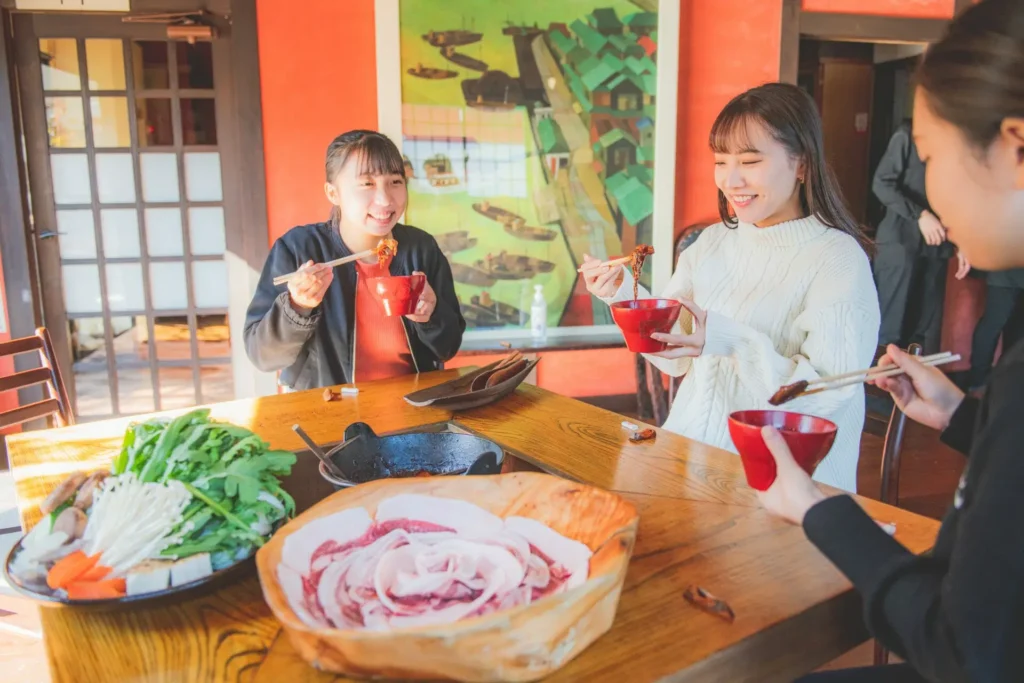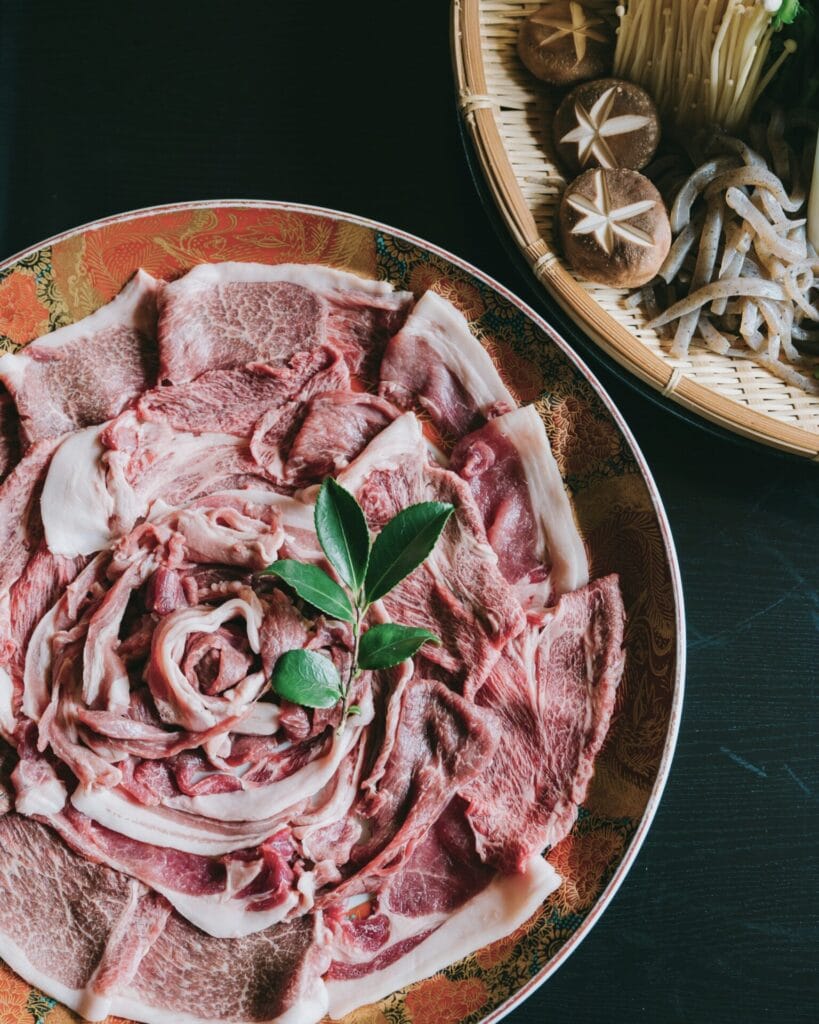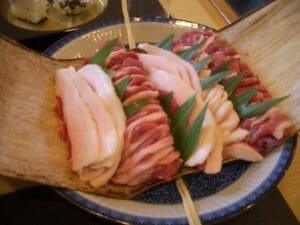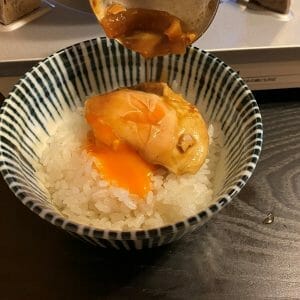Tambasasayama — The home of Botan nabe
The city of Tambasasayama is known as the home of Botan nabe, a hot pot made with wild boar meat. Originally known as ‘Ino nabe,’ it has been cherished as a local hospitality dish. (Ino is a shortened form of Inoshishi, which is the Japanese word for wild boar.) In the early Showa period (1926-1989), when the lyrics for ‘Sasayama Kouta’ (song) were solicited, the name Botan nabe was created for its catchy sound, and it became widely known.
A few years later, inspired by this name, the practice of beautifully arranging wild boar meat to resemble peony flowers became popular, and today, this elegant presentation has become the standard for Botan nabe.
Although it is often said that the dish was named after its peony-like appearance, in fact, the opposite is true. The name came first, and the decorative plating style followed.
Note: For the latest Botan Nabe Guide, please check the PDF version in this link (Japanese only)
Note: Price subject to change. Please contact the restaurant directly for the latest pricing.
Botan nabe trivia! The History of the Cuisine
People have been eating wild boar meat since the Jomon era (8000 BC – 2000 BC). During the period when meat consumption was prohibited due to the introduction of Buddhism, local people enjoyed wild boar meat calling it “mountain whale”, as a way to obtain valuable protein.
In the Edo era (1603–1868), people began referring to wild boar meat as “botan” for the same reason. This naming custom was not limited to wild boar, horse meat was called Sakura (cherry blossom), and deer meat was called Momiji (maple leaves).
When the restriction of eating meat was lifted in the Meiji era (1868–1912), people began calling the miso-flavored hot pot made with wild boar meat Ino-nabe.
Tambasasayama’s wild boar meat became popular nationwide around 1908, when soldiers of the Imperial Japanese Army’s 70th Infantry Regiment ate it as a nutritious miso soup. The meat they enjoyed came from boars taken from the mountains of Tamba during training. The reputation of the exceptionally delicious taste of Tambasasayama’s wild boar meat spread across the country as the soldiers shared their experience after returning home.
In 1931, the predecessor of the Sasayama City Chamber of Commerce invited submissions for lyrics to the folk song “Sasayama Kouta”, in which the term “Botan nabe” appeared for the first time in the fourth verse. The four-character Japanese word Ino-nabe did not fit in the rhythm of the song, so the five-character Japanese word Botan Nabe was used instead.
Mitake oroshi ni mau yuki no, mado no ozasa ni tsumoru yowa, youte motarete omowarete, tagiru nasake no botan nabe
Interpretation of the song’s lyrics
Snow swirls in the wind blowing down from Mt. Mitake.
On a night when snow piles up on the small bamboo tree outside the window, a couple enjoys Botan nabe and sake together.
The woman, slightly tipsy, leans gently against the man.
As he watches her, his heart begins to boil with affection—just like the simmering Botan nabe before them.
Around 1945, a long-established local inn began beautifully arranging the wild boar meat to resemble peony petals, inspired by the name “Botan nabe”. This is how the name “Tambasasayama Botan nabe” spread throughout Japan.
Note: The name ‘Botan-nabe’ was created first, and the presentation resembling peony flowers was devised to match this name.
In 2007, Botan-nabe was selected as one of the representative dishes of Hyogo Prefecture in the ‘100 Best Local Dishes of Rural Japan’ compiled by the Ministry of Agriculture, Forestry and Fisheries. In 2022, it was also chosen as part of the 100 Year Food program, certified by the Agency for Cultural Affairs, and received the Special Experts’ Award. Currently, there are about 40 restaurants in Tambasasayama that serve Botan nabe.
Influencing the Price of Botan-nabe: What Are the Cuts of Wild Boar Meat?
The wild boar meat available at Tambasasayama’s stores and restaurants is completely natural, not farm-raised. Running through the mountains of Tambasasayama and feeding on nuts such as Tamba chestnuts, Tamba matsutake mushrooms, and various grains, these wild boars build up just enough fat to survive the winter. That’s why it is lean and not greasy, offering a refreshing taste.
Note: The polyunsaturated fatty acids abundant in wild boar meat help reduce LDL cholesterol and contribute to thinning thick blood.
Note: The standard serving of meat in Botan nabe for one person is about 150–200 grams
・ Loin: tender and mild in flavor (excellent fat quality, a rare cut)
・ Chuck: rich and flavorful
・ Belly: packed with umami; the fat tastes expecially good!
・ Back rib: slightly tougher, releasing umami as you chew
・ Picnic(shoulder): lean meat with a deep, savory taste
・ Thigh: well-balanced lean and fatty meat
・ Cut-off meat: affordable and perfect for home cooking
A Botan nabe made entirely with loin meat would be quite expensive, so combining different cuts is a good way to enjoy the dish more affordably.
How Cutting Adds Value to Wild Boar Meat!
Some restaurants are particular about using hand-cut techniques for the meat.
Hand-cutting takes more time and effort compared to using machines. Also, slicing the meat thinly and evenly requires experience, and the final presentation relies on the chef’s skill.
Despite these challenges, hand-cutting makes it possible to remove tiny tendons and excess fat that machines cannot handle, allowing the chef to tailor each slice according to the desired cut. This results in meat that has a tender, easy-to-eat texture that many people enjoy.
(In this case, arranging the meat to resemble peony petals can be quite challenging.)
The Unique Dashi Broth Enhances Botan Nabe
The northern part of Hyogo Prefecture is known for sansho, a type of Japanese pepper. The traditional way to prepare Botan nabe is to simmer it with miso (soybean paste) and add a touch of sansho for spice. However, new styles of preparation have been emerging one after another.
・Blended miso
・White miso
・Warishita (a soup base made with soy sauce, sugar, mirin [sweet rice wine], and sake)
・Shirodashi (a light-colored soy sauce mixed with dashi; sweeter and more savory than regular soy sauce)
What these variations have in common is each chef’s commitment to creating their own unique ‘dashi.’ When the special dashi blends with the natural broth from the wild boar meat, it results in a truly delightful dining experience. And as the dashi changes, so does the choice of ‘shime’—the final dish of the meal. Enjoy various styles of Botan nabe, such as udon, zosui, or rice topped with a soft-cooked egg, tailored to your preferences.
Note: In Japan, ‘shime’ refers to the final course of a hot pot meal, typically made by adding starch-based foods such as udon noodles, rice porridge, or rice topped with a soft-boiled egg.
この投稿をInstagramで見る
List of the shops & restaurants in
Gibier de Tambasasayama
| Name | Address (link to Google Map) | Feature | |
| 1 | Cooking inn Takasago | 6 Nikaimahi | -meal only plan available -slightly thick taste -matches best with beaten egg |
| 2 | Ryoriryokan Iketomi | 125 Tatsumachi | -meal only plan available -special miso aged for two years -hand-cut raw meat |
| 3 | Jinyourou | 79 Nikaimachi | -meal only plan available -slightly rich taste -grilled boar meat available |
| 4 | Tambasasayama Kinmata | 81 Nikaimachi | -Botan nabe Kaiseki (course meal) only -grilled boar meat available |
| 5 | Tambasasayama Local Cuisine, Kai | 58 Nikaimachi | -booking not required -slightly light taste -a specialty store |
| 6 | Sasayama Tamamizu | 148 Inuishinmachi | -reservation only -moderate sweetness light -parking available |
| 7 | Tokusan Kan Sasayama | 70-1 Kurooka | -booking not required -White miso base -one person hot pot set meal available |
| 8 | Morimoto-ya in Kusayama | 476-1 Kuwabara | -slightly sweet and rich -homemade miso popular for take-out |
| 9 | Nyogetsu-an | 123 Kitashinmachi | -reservation required for dinner -miso with chestnuts -branch store: Botantei |
| 10 | Mountain village cuisine Maekawa | 93 Tatsumachi | -Botan-nabe (wild boar hot pot) course meal *The hot pot is flavored with broth, not miso. |
| 11 | Wild boar restaurant Okuei | 492-5 Fujiokaoku | -a little light -fresh meat all year round from the directly managed ranch |
| 12 | Ohte Shincho | 71 Nikaimachi | -booking not required -a hot pot for one person available |
| 13 | Ishiyaki Kobo Season | 264 Sugi | -reservation required -boar meat grilled on a natural stone plate is popular |
| 14 | Restaurant Sanmon | 116 Tokochi | -provide fresh raw meat -also popular as the wild boar meat store |
| 15 | Ajidokoro Mitake | 683 Kurooka | -reservation required -hot pot for one person available -Saba(mackerel) sushi is also popular |
| 16 | Hanakoushi | 160 Kawaramachi | -reservation required -modest sweetness -White miso -soba nuts porridge for shime |
| 17 | Shishigin, Sue no Sato store | 3 Kondacho Kamitachikui | -Shabu-shabu with rich white dashi. -using only 3-year-old female wild boar |
| 18 | Zensho Tannan Saryo | 92-4 Ajimashin | -reservation required -sukiyaki style with Warishita -grilled wild boar |
| 19 | Morimotoya | 441 Miyata | -Enjoy with sushi |
| 20 | Tamba Sasayama Ikkyuan | 78-2 Yamauchicho | -Enjoy with soba |
| 21 | Honke Kumanoen | 456 Ajimaoku | -Enjoy with Tamba tea |
| 22 | Hanapara | 52-1 Ajimashin | -Enjoy with various dishes |
| 23 | Ryorisha Yamayu | 81Agake | -Enjoy with Tororo (grated yam) |
| 24 | Hogyoen | 52 Kawakitashinden | -Enjoy with fish |
| 25 | Tambasasayama Matsukazeya | 95 Higashikosa | -reservation required -blended miso -local chicken dishes are also popular |
| 26 | Uo Sei | 56-1 Hioki | -Enjoy with fish |
| 27 | Tamagawarou | 32 Gofukumachi | -Enjoy with various dishes |
| 28 | Yu no Tsubo | 79 Shitsukawa Shinden | -Kagobo Onsen -possible to have meal only (w/o staying) -White miso-based soup |
| 29 | Tamba Inomura | 1154 Shitsukawa | -athletics course available -accommodation and camping are possible |
| 30 | Unitopia Sasayama | 231-1 Yashiro | -possible to have meal only (w/o staying) -One-day hot springs available -Popular with children |
| 31 | Lodge S.P.H. | 956-1 Higashibuki | -possible to have meal only (w/o staying) -Sukiyaki / Shabu-shabu available -Inokotsu soup(wild boar bone broth) |
| 32 | Umetan FUJI | 65-3 Ofuji | -An inn that is popular for its game meat cuisine.-Meals without staying overnight are available. -One-pot dish to be enjoyed with light soup stock and grated yam |
| 33 | Holonpia Hotel | 76-4 Nakano | -modest sweetness -a little light -local orange Chinese cabbage used |
| 34 | Shin Tambaso | 451-4 Gunge | -possible to have meal only (w/o staying) -reservation required -One-day hot spring available |





